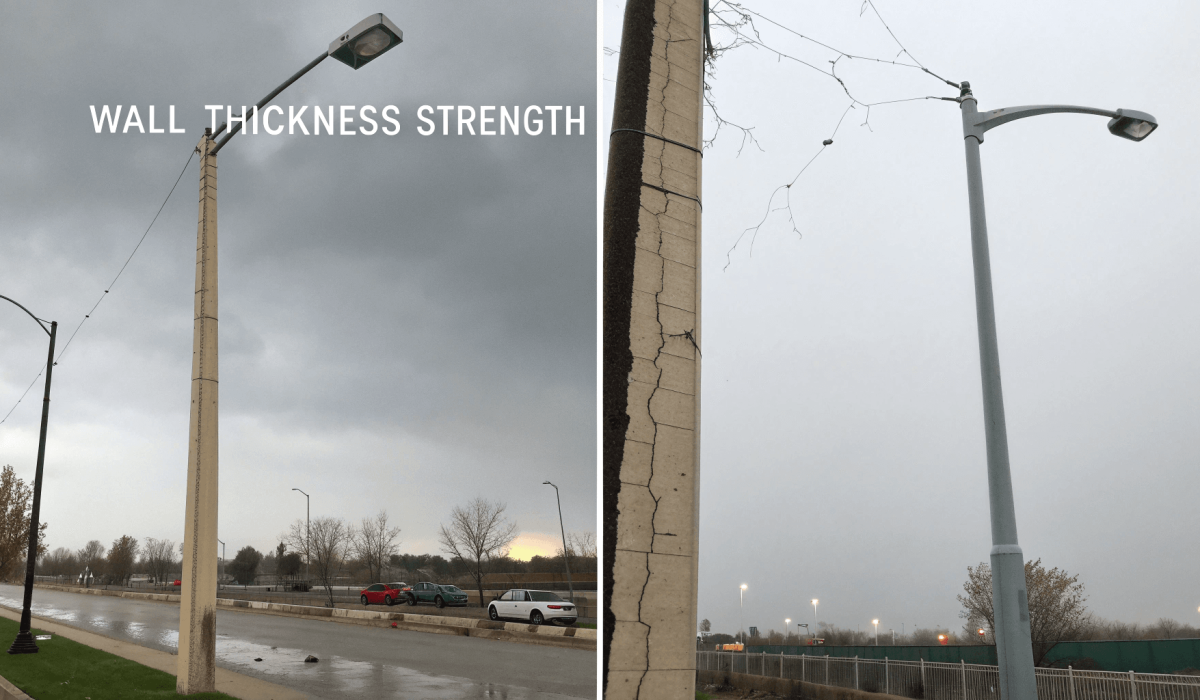Overlooking wall thickness in street light poles can lead to structural failure, increased maintenance, and shortened service life.
Wall thickness is a core factor that determines a street light pole’s strength, durability, and long-term cost-effectiveness.
Let’s explore why thicker walls mean better performance, and how to choose the right specs for your projects.
Why Is Wall Thickness Important for Street Light Poles?
Street light poles are more than vertical structures—they support lighting, withstand weather, and ensure public safety.
The thickness of the pole's wall determines how well it handles stress, resists corrosion, and lasts over time.
When I started working on street lighting projects in coastal West Africa, I quickly learned that cheap poles with thin walls corroded within two years. The stronger, thicker ones? Still standing after five—and counting.
Let’s dive into how wall thickness works.
What Does Wall Thickness in Poles Actually Mean?
Wall thickness is the distance between the outer and inner surfaces of the pole tubing.
Measured in millimeters (mm), it directly impacts how much weight and force the pole can handle.
Here’s a simple reference chart:
| Wall Thickness (mm) | Typical Usage |
|---|---|
| 2.5 mm | Residential/pathway poles (low wind) |
| 3.0–3.5 mm | Municipal street lights (urban settings) |
| 4.0+ mm | Highways, industrial, or coastal areas |
In manufacturing, we often recommend a minimum of 3.0 mm for any public-use pole above 6 meters. Why? Because it handles both the light fixture load and wind loads much better than lighter profiles.
How Does Wall Thickness Affect Pole Strength?
The thicker the pole wall, the more pressure and stress it can withstand.
Pole strength isn’t just about the material—it’s about how much of that material is there to resist bending, breaking, and swaying.
Here’s how wall thickness helps:
-
Wind Resistance
Thick-walled poles are more stable in high-wind zones. They are less likely to bend, crack, or break when facing storms or daily gusts. -
Load-Bearing Capacity
Stronger walls support heavier fixtures like cameras, signage, or dual-arm lights. This is crucial for smart city setups or floodlight systems. -
Vibration Dampening
Environmental factors like passing vehicles or strong winds cause vibrations. Thicker walls absorb and reduce this movement, minimizing long-term fatigue.
Think of it like this: would you rather balance a camera on a thin broomstick or a steel pipe? The same logic applies to pole installations.
How Does Wall Thickness Influence Longevity?
Wall thickness directly impacts how long a pole can stay in service with minimal issues.
Thicker poles resist corrosion longer, reduce maintenance needs, and lower total ownership costs.
Let’s break it down:
-
Corrosion Resistance
In salty or humid climates, corrosion eats away at poles. Thicker walls take longer to degrade—so the pole stays safe longer. -
Maintenance Requirements
Thin-walled poles develop cracks, flake coatings, and corrosion faster—leading to more frequent repairs or early replacements. -
Lifecycle Cost
While thicker poles cost more upfront, they offer lower maintenance and longer life. Over 10 years, they usually save money.
Here’s a quick cost comparison:
| Feature | 2.5 mm Pole | 3.5 mm Pole |
|---|---|---|
| Initial Cost | Lower | Moderate |
| Maintenance Cost | High (frequent checks) | Low (minimal issues) |
| Service Life | 3–5 years | 10+ years |
| Total 10-Year Cost | Higher (due to repairs) | Lower (one-time setup) |
I often tell clients: “Spend a little more now, save a lot later.”
What Are the Industry Standards for Wall Thickness?
There are no one-size-fits-all specs, but general guidelines exist based on pole height and location.
Always factor in local weather, wind zones, and pole usage when choosing wall thickness.
| Pole Height (m) | Standard Wall Thickness (mm) | Typical Application |
|---|---|---|
| 5–6 | 2.5–3.0 mm | Residential pathways |
| 7–9 | 3.0–3.5 mm | Urban streets, parking lots |
| 10+ | 4.0–5.0 mm | Highways, airports, coastal |
Special Considerations:
- Coastal Zones: Salt air speeds up corrosion—use thicker poles + hot-dip galvanization
- Mountainous Areas: High winds demand stronger base and walls
- Smart City Poles: Add-ons like sensors and signage increase load
In our Togo expansion, we adjusted standard pole specs to 3.5 mm minimum due to heavy rains and ocean proximity. It was worth every cent.
What Can Real-World Projects Teach Us?
Let’s look at a few lessons from the field where wall thickness made the difference.
Case 1: Coastal Town Street Upgrade (Ghana)
- Original poles: 2.8 mm wall
- Issue: Rusted through within 2 years
- Solution: Switched to 4.0 mm with epoxy coat
- Result: 5 years later, zero failures
Case 2: Smart City Pilot (Uganda)
- Fixtures included Wi-Fi modules and CCTV
- Needed stronger base support
- Used 3.5 mm poles with reinforced bases
- Result: Stable data, no pole fatigue after 3 years
Industry professionals agree: you can’t cut corners on wall thickness. It’s one of the most important specs to confirm before ordering.
Conclusion
Wall thickness is not just a number—it’s a key factor in a pole’s strength, safety, and lifespan. Thicker poles stand stronger against wind, support more weight, resist corrosion longer, and cost less to maintain. Don’t skip this detail. For every project, choose your pole specs with care—and don’t let cost-saving today create problems tomorrow.


